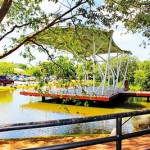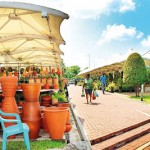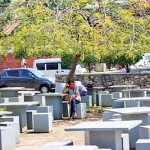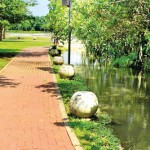Can charge a ticket for entering Diyatha Uyana Wetland Park?
View(s):Most wetlands in cities are designated as wetland parks, because of the dual roles they play in ecosystem maintenance and provision of social services such as relaxation and recreation. The cities depend on ecosystems beyond city limits, they also benefit from internal urban ecosystems (with environmental amenities) located within urban landscapes, which provide a range of ecosystem services to nearby residents.
In the past, the notion that wetlands were wastelands, a notion which had to do with both ignorance and misunderstanding of the value of the goods and services they provide, had led to their conversion into intensive agricultural, industrial and residential uses. Today, it is understood that wetlands are amongst the earth’s most productive ecosystems described variously as “the kidneys of the landscape” because of the functions they perform in the hydrological and chemical cycles and as “biological supermarkets” for the extensive food webs and rich biodiversity they support.
- Prof. Wasantha Rathnayake (Professor in Environmental Management)
The Diyatha Uyana Wetland Park (DUWP) in Sri Lanka is today recognised as an important recreational site in the Greater Colombo area in Sri Lanka. The availability of food stalls, meeting points, walking paths, daily fairs offering different items, and small shops for purchasing day-to-day needs and places for relaxation are among its major attractions. While visitors to the Park expend money to enjoy the environmental services, their recreational value has not been estimated. The upkeep of DUWP entails a high maintenance cost on the part of the Government of Sri Lanka as it extends over a large area. It is argued that if the park generates more welfare benefits, at present the park levies no an entrance fee from visitors although the Municipal Council allocates a considerable amount of funds for the upkeep of the park.
Individual travel cost method was applied by our research team to assess the value of the welfare benefits in monetary terms that the visitors accrue by visiting DUWP. The study also examined the impact of imposing an entrance fee on regular visitors to the site and assessed the changes in welfare benefits with the imposed entrance fee, and the present value of non-market benefits provided to users if the authorities continue to preserve the site as a natural recreational area. This would greatly facilitate decision-making on effective resource allocation for recreation purposes as well as wetland conservation.
From the estimates, it can be said that an individual receives an estimated welfare benefit (satisfaction) of Rs. 512.82 in terms of consumer surplus (in economic terms). This finding confirmed that the amount of welfare benefits generated at DUWP is the motivation factor for visiting DUWP. Further, based on the estimated welfare benefits an entrance fee to a wetland park can be determined.
According to the economic theories, consumer surplus is defined as the difference between the total amount that consumers (here visitors) are willing and able to pay for a good or service and the total amount that they actually do pay.
Accordingly, DUWP generates an estimated welfare benefits of total Rs. 9358.90 million per year. These calculations represent the value of access to the site derived by measuring the recreational value that would be lost if the wetland park was to disappear or, equivalently in the case of recreation, if no recreational visitors were allowed to visit the park. However, the government would benefit from knowing the recreational value of the wetland park when making decisions regarding its future uses. This study measured the impact of a direct entrance fee. If an entrance fee is introduced (at Rs. 80.00 which is the fee levied at parks in Sri Lanka, the Government of Sri Lanka would earn Rs. 144.85 million annually. But the findings indicate that there would be a reduction in social welfare benefit with such a fee.
However, considering the estimated revenues to be had from such an entrance fee, the government would do well to think of possible alternative fund-generating strategies. As the imposition of an entrance fee is not practical given the multiple recreational sites (without precise boundaries) throughout the wetland, imposing a reasonable vehicle parking fee, facilities enjoying fee, and sanitation fee would be more appropriate which has the added benefit of reduced congestion and pollution. It is a fact that the DUWP has been deteriorating in quality as a recreational site owing to ineffective management during recent years. Hence, it is timely that the Government gives serious thought both to revenue generation and to providing funds to maintain the wetland. The total welfare benefits generated from the wetland would be far higher than Rs. 9358.90, if the other use- and non-use values were incorporated into it. But the findings also indicate that there will be a reduction in welfare benefits with such a higher fee. However, considering the estimated revenues to be earned from such an entrance fee, the government could think of possible alternative fund-generating strategies.
The calculations show that the present value of non-market benefits from preserving the park is Rs. 9358.90 million (or USD 46.79 million) per year at the 10% discount rate. This is equal to Rs. 234 million per perch, which is approximately 78 times greater than the existing land value of the area (at Rs. 2-3 million per perch). We measured the benefits in perpetuity assuming that the wetlands will be preserved in their natural state indefinitely. But it is worthy of note that the recreational benefit is just one of the numerous benefits provided by the wetlands and that we have not included the other use- or non-use values in the analysis. Including these benefits would undoubtedly increase the present value of the wetlands and strengthen the case for preservation over development. We were also not able to calculate the cost of open space, which is the value of services foregone by not allocating recreational land to other alternative land uses such as commercial
and residential.
Biography
Prof. Wasantha Rathnayake is a distinguished Professor in Environmental Management attached to the Faculty of Management Studies, Sabaragamuwa University of Sri Lanka. He was the Dean of Faculty of Management Studies from 2011 to 2017. Prof. Rathnayake has made a great contribution towards the conservation and management of wildlife and natural resources in Sri Lanka covering the areas of strategic planning, policy formulation and protected area management. He served as a Deputy Director at Department of Wildlife Conservation before joined the University system. He served more than five years as the Focal Point (representative) of Sri Lanka for Ramsar Convention and Indian Ocean South East Asia Memorandum of Understanding for Turtle Conservation (IOSEA). Prof. Wasantha Rathnayake is an outstanding researcher, and he has published more than 80 research articles, book chapters, conference papers and abstracts, including articles indexed in Science citation index and social science index and refereed journals. The most important thing is that his research findings are not only important for academic purposes but also very useful for the national development in Sri Lanka.











